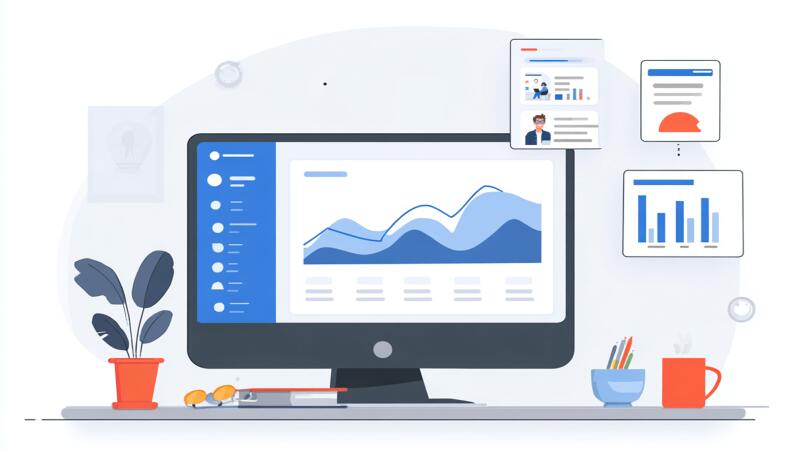In the ecosystem of search engine optimization, links remain one of the key factors determining a website’s position in search results. Regardless of the development of ranking algorithms, Google and other search engines continue to use a website’s link profile as an indicator of authority and trustworthiness. Strong link popularity means that your site is being linked to by authoritative, thematically relevant sources, suggesting that search engines see it as valuable and worthy of attention.
However, link popularity itself is not just about the number of links. It is a combination of metrics reflecting their quality, relevance, diversity, and naturalness. Poorly thought-out work with external links can not only fail to improve but also harm the site, triggering filters or causing a drop in rankings. Therefore, understanding the principles of link profile evaluation and skillful link popularity building is an essential part of any modern SEO strategy.
In this material, we will explore what link popularity is, how it differs from link mass, which tools and metrics can help evaluate it, and which methods truly work in 2025. You will receive a structured guide on increasing a website’s authority in the eyes of search engines, applicable for both new projects and already established resources.
What is Link Popularity
Link popularity of a website is an indicator reflecting how often and from which sources other websites on the internet link to it. It is determined by a combination of two key factors: the number of external links (backlinks) and the authority of the sources where these links are placed. It’s not just about the quantity of links, but also their quality: the relevance of the topic, trust in the donor, and the naturalness of the placement.
The more authoritative and thematically relevant resources link to a site, the higher its link popularity. For search engines, this is a signal that the site is valuable to the audience and deserves higher positions in search results. In modern SEO, link popularity is considered an important indicator of a resource’s reputation and demand on the web.
Difference Between Link Popularity and Link Weight
Despite the similarity of terms, link popularity and link weight refer to different metrics.
- Link Popularity is an external metric that describes how much a site is mentioned on the internet and the quality of those mentions. It is more like the social capital of a site in the link space.
- Link Weight (PageRank, Link Juice) is an internal metric that describes how much value one page passes to another through a link. It is calculated by search algorithms and is distributed among pages both within a site (internal linking) and between different sites.
Simply put, popularity shows how much and how well people talk about you, while weight indicates how much benefit each of these links passes within ranking algorithms.
The Evolution of the Role of Links (from PageRank to 2025)
In the late 1990s, Google introduced the revolutionary PageRank algorithm, which evaluated pages based on the quantity and quality of incoming links. At the time, this became a key ranking factor, and SEO strategies were built almost exclusively around building link popularity.
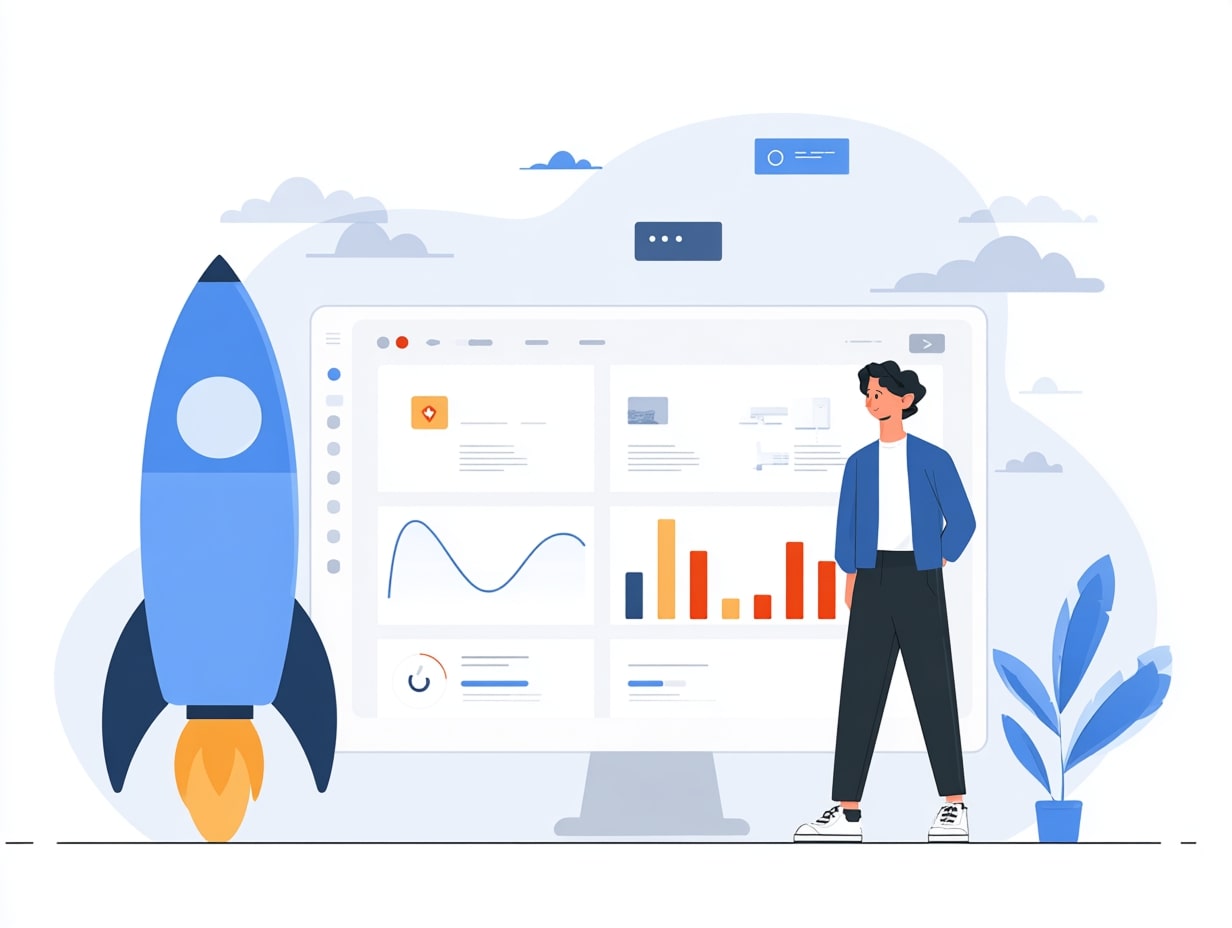
In the early 2000s, the link market experienced a boom: mass link buying, link farms, and satellite sites allowed for rapid ranking improvement. However, as manipulation grew, Google began to tighten the rules. The launch of the Penguin algorithm (2012) was a turning point – it learned to identify unnatural links and demote sites using spammy methods.
Since the mid-2010s, the priority has shifted from quantity to quality: search engines started to consider the relevance, trustworthiness of donors, and the naturalness of the anchor list. Complex systems for assessing authority emerged – Trust Flow, Domain Rating, as well as factors related to expertise and reputation (EEAT).
By 2025, links remain a significant factor, but their influence is integrated into broader algorithms that consider context, behavioral metrics, and semantic analysis. Today, a successful link-building strategy is not a race for quantity but a comprehensive effort to enhance a website’s reputation and media presence.
Why Links Remain One of the Main Ranking Factors
Despite the development of artificial intelligence algorithms, the growing role of behavioral factors, and content quality, links continue to be one of the main signals for search engines. The reason is that they perform several functions: they confirm a website’s authority, help understand its thematic relevance, and provide navigation for search bots.
Links can be seen as votes of trust: if authoritative sites link to a resource, it confirms its value to the search engine. Combined with other factors (high-quality content, user-friendliness, fast loading speed), a strong link profile increases the chances of reaching the top. Incorporating link popularity analysis into your strategy can further enhance these efforts.
| Link Function | Impact on Ranking | Example |
|---|---|---|
| Authority Transfer (PageRank, Trust) | Increases the page’s weight, improving its position in the search results | A link from the homepage of a major industry portal |
| Topical Relevance | Helps the search engine determine which queries to promote the page for | An article about SEO linking to your internet marketing blog |
| Navigation for Search Bots | Ensures indexing of pages that might otherwise go unnoticed | A deep internal page found by a bot through an external link |
| Trust Enhancement (E-E-A-T) | Increases the perception of the site as expert and trustworthy | Mention in a scientific publication or on a well-known expert’s site |
| Indexing Acceleration | New pages are indexed faster | A press release with a link to a new page posted on a news portal |
Thus, links are not only a tool for weight transfer but also a complex signal that search engines integrate into the overall model for evaluating a website’s quality.
Myths and Realities of Link Popularity in 2025
Link popularity remains one of the key ranking factors, but its perception has changed significantly in recent years. Search engine algorithms have become more sophisticated, and old tactics have stopped working. Let’s explore what is myth and what is reality in 2025.
Myth 1: The more links, the higher the rankings.
In the past, the number of external links could indeed directly influence ranking growth. Fifteen years ago, the strategy of “the more, the better” often yielded quick results: mass purchase of links on exchanges or through automated programs could push a site to the top in just a few weeks.
In 2025, the situation is the opposite. Search engine algorithms, including Google SpamBrain, are capable of:
- Detecting mass purchases of low-quality links
- Analyzing the thematic and contextual relevance of donors
- Considering the natural distribution of link mass over time
Mass purchasing of cheap links from irrelevant sites often leads to:
- Filters and penalties, up to the complete removal of pages from search results
- Dilution of link weight, where the value of each individual link decreases
- Reduced trust from algorithms towards the site
A website’s popularity is determined by its ability to build link popularity in a natural and relevant manner, aligning with these advanced algorithmic expectations.
The real approach in 2025 is a balanced and gradual build-up of link popularity through a combination of methods: guest posts, Digital PR, crowd marketing, and other strategies, with a focus on the quality and relevance of the donors.
Myth 2. You can create an anchor list once and forget about it.
An anchor list is a collection of texts used in links, and it is one of the key signals for algorithms. In 2025, a static, monotonous anchor list can cause problems: search engines see this as unnatural and recognize such a profile as manipulative.
Common mistakes include:
- Overusing exact keyword matches – it looks like spam, especially if such anchors exceed 20–30% of the total number.
- Lack of branded and non-anchor links – creates an artificial profile that is easily filtered by algorithms.
- Ignoring local peculiarities – anchor patterns can vary significantly across different niches and countries.
The reality in 2025 is that an anchor profile needs:
- Monitor monthly – check the distribution of anchor types and adjust the strategy.
- Adapt to changes in algorithms and competition – for example, Google has become more active in considering the context around the link, not just the anchor itself.
- Adjust for different sources – for crowd links and Digital PR, anchors are often natural, while for guest posts, they are moderately optimized.
Keeping the anchor list up-to-date is not a one-time task but a continuous process, and without it, sustainable growth in rankings is unlikely.
Myth 3. Free links are useless.
Many still believe that crowd links, profiles, directories, and other free sources do not have a noticeable impact on rankings. This belief has formed because these links often have low DR/DA metrics and do not pass significant “link juice.”
However, in 2025, search algorithms have a broader perspective:
- They evaluate the naturalness of the entire link profile. If it consists only of expensive guest posts and media publications, but lacks natural mentions from forums, social media, and Q&A, the profile appears artificial.
- Free links create a background and diversity, helping to diversify the anchor list and add branded and non-anchor mentions.
- Such links can bring direct traffic and conversions: a thematic forum or a discussion on Quora often leads interested users to the site.
Free links do not replace quality paid placements but enhance their effect and make the profile safer. Properly selected crowd marketing and directories are integrated into a link-building strategy and work for long-term results.
Myth 4. Search engine algorithms don’t see PBNs.
PBN (Private Blog Network) – a network of sites created to pass link juice to the main resource. At one time, such networks could indeed remain unnoticed for a long time. Today, the situation is different:
- Google and other search engines use machine learning and pattern analysis to detect PBNs: identical IP addresses, hosting, CMS, recurring themes, and content structure.
- Linking schemes and user behavior are analyzed. If all network sites link only to one or two resources and do not have natural traffic, the risk of penalties increases.
- Even a unique design won’t help if the content is mediocre or copied.
Reality: PBNs can only be used effectively with careful implementation, featuring unique and valuable content, distributed hosting, clean domains with history, an organic link structure, and maintaining a natural posting pace. It is a complex, costly, and risky tool that requires experience and regular maintenance.
Myth 5. Digital PR is only for big brands.
A few years ago, Digital PR was perceived as a tool used exclusively by large companies with million-dollar budgets. Indeed, media and influential blogs often wrote about international corporations, high-profile startups, and famous personalities.
In 2025, the situation changed:
- Media outlets have become more open to publications from small and medium businesses if the material proposed is interesting to their audience.
- Numerous niche platforms, industry portals, and themed blogs have emerged, where one can secure a publication without the “brand weight” of a Coca-Cola or Apple.
- Digital PR has become more affordable thanks to services that handle platform selection, create news hooks, and communicate with journalists.
Effective Digital PR is not about the size of the brand but the quality of the story, the relevance of the platform, and skilled outreach. Even a small e-commerce, a local IT company, or a B2B service can secure publications in media and industry blogs, attract traffic and leads from relevant audiences, build natural links that positively affect SEO, and strengthen their reputation within their niche. With the right strategy, you can enhance link popularity in SEO and ensure a website’s popularity is determined by its quality content and outreach.
At LinkBuilder.com, we implement Digital PR campaigns for businesses of any scale: we develop news hooks, create materials, engage in direct negotiations with journalists and bloggers, and achieve publications that provide both reputational and SEO value. This approach allows medium-sized businesses to compete with large players not with budget, but with quality content and the right strategy.
Want to ensure your strategy aligns with the realities of 2025? Contact LinkBuilder.com for an audit and a link popularity development plan.
How Search Engines Analyze Your Website’s Link Popularity
Search engines view a link profile as the collection of all links leading to a site and analyze it from various angles: types of links, their origin, anchor texts, authority of the donors, and the dynamics of their appearance. The quality of a link profile determines how authoritative a website will be considered in its field.
Internal and External Links
- Internal links are hyperlinks between pages of a single website. They help distribute link equity within the resource, provide convenient navigation, and speed up the indexing of new pages. Well-configured internal linking strengthens the positions of key pages.
- External links are links from other websites. They play a key role in building link popularity and the domain’s authority. The quality of external links is determined by the authority and topical relevance of the referring site, as well as the naturalness of placement.
Algorithms and Signals Considered
To assess the quality of a link profile, search engines and SEO tools use a range of algorithms and metrics. Some of these are developed by the search engines themselves (such as PageRank), while others are from third-party services (Ahrefs, Majestic, Moz), which simulate and approximate the evaluation of a link profile to the search engine’s logic.
| Metric / Algorithm | What it Measures | Why it Matters |
|---|---|---|
| PageRank (Google) | Link weight passed based on the quantity and quality of links | A fundamental algorithm for assessing page value through a network of links |
| Trust Flow (Majestic) | The level of trust in a site based on proximity to trusted sources | Allows evaluation of the quality of link mass |
| Citation Flow (Majestic) | The “citation” of a site – the number of links, without considering their quality | Used alongside Trust Flow to assess the balance of link quantity and quality |
| Domain Rating (Ahrefs) | Comprehensive assessment of a domain’s link profile strength on a scale from 0 to 100 | Helps compare the authority of websites with each other |
| Spam Score (Moz) | The likelihood that a site or links will be perceived as spam | Important for filtering toxic donors |
As a result, search engines receive a multidimensional model that considers not only the links themselves but also their context: anchor list, diversity of donor domains, distribution of link weight, and link growth rate. A balanced profile that combines diversity and relevance gives a site stable positions in search results. Integrating link popularity analysis can further enhance a website’s ability to maintain strong rankings in search engine outcomes.
Experts at LinkBuilder.com work daily with factors that search engines consider when evaluating a link profile. Over the years, we have gathered and continuously expanded the industry’s largest database of donors and a set of tools for managing links, ranging from selecting relevant platforms and analyzing anchor lists to controlling the pace of link growth and distributing link weight. At LinkBuilder.com, you can:
- Quickly find relevant donors from a database of hundreds of thousands of sites by filtering them based on DR/DA, traffic, region, topic, and other quality parameters.
- Place free crowd links, submissions, anchor or branded links from profiles, Quora, directories, and other sources.
- Manage the entire process from your personal account, from searching for platforms to ordering guest posts, with the ability to scale and receive priority support.
- Order comprehensive services: link building, guest posts, PBN networks, SEO copywriting, strategies, indexing acceleration, and White-label solutions for agencies.
Link popularity services are essential in building a website’s popularity, and this platform provides the tools necessary for effective link popularity building.
We constantly update our database of platforms and expand our tools so that you can build your link popularity faster and more efficiently. If you want to build a strong and safe link profile that meets search algorithm requirements, order guest post placements, crowd links, or a comprehensive strategy.
Quality Factors of Donors for Link Popularity
When promoting a site through links, one of the key aspects is the quality of donors – the sites that host your external links. Not all links are equally beneficial: the authority and relevance of the donor determine how effectively a site’s link popularity will increase and improve its link profile.
Key factors to pay attention to:
- Domain Age. Websites with a history and stable reputation convey more trust to search engines. New resources, even with good content, carry less weight in evaluating a website’s link popularity.
- Topical Relevance. It is important for the donor to be in the same or a related niche. Relevant links better reflect the site’s expertise and organically boost link popularity.
- Organic Traffic. If a resource attracts visitors from search engines, links from it have a greater effect because they are in the context of an active audience. This is one of the key elements in link popularity analysis.
- Spam Score. A high spam score indicates an unreliable resource. Links from such sites may not only fail to help but can also harm. Donor quality control is part of link popularity building strategies.
Using these factors when planning a link popularity campaign helps not only to increase the number of links but also to build a quality link profile that truly impacts website ranking.
The Role of Anchor Lists and Link Types
When promoting a website through links, the anchor list plays a crucial role – the link text that users and search engines see. A variety of anchor texts helps create a natural link profile and avoid penalties for keyword stuffing. A balanced anchor list contributes to building a quality link profile and increases the effectiveness of a website’s link popularity.
Equally important is the distribution of link types: dofollow, nofollow, sponsored, UGC.
- Dofollow passes link equity, directly influencing the site’s link weight and its positions in search results.
- Nofollow does not directly pass weight but supports the naturalness of the link profile and helps search engines evaluate the organic nature of the links.
- Sponsored is used for paid placements; its correct application is crucial for meeting Google’s requirements and safely enhancing the link profile.
- UGC (User Generated Content) – links created by users (comments, forums), help to form diversity and naturalness in link popularity.
Control over the anchor list and types of links is part of strategies to build link popularity. The right combination of these elements enhances the effectiveness of link promotion and improves the site’s visibility in search results.
Why Link Popularity is Important for Promotion
A website’s popularity is determined by its link popularity, which directly affects its position in search results. Search engine algorithms evaluate not only the number of external links but also their quality, relevance, and the authority of the donors. High link popularity signals that a site is valuable to users and trustworthy to search engines.
Popular sites typically have a strong link profile: a large number of quality links from relevant resources ensures stable link promotion and strengthens its position in the results. This is one of the key factors that determine how link popularity in SEO influences rankings and which resources gain advantages during ranking.
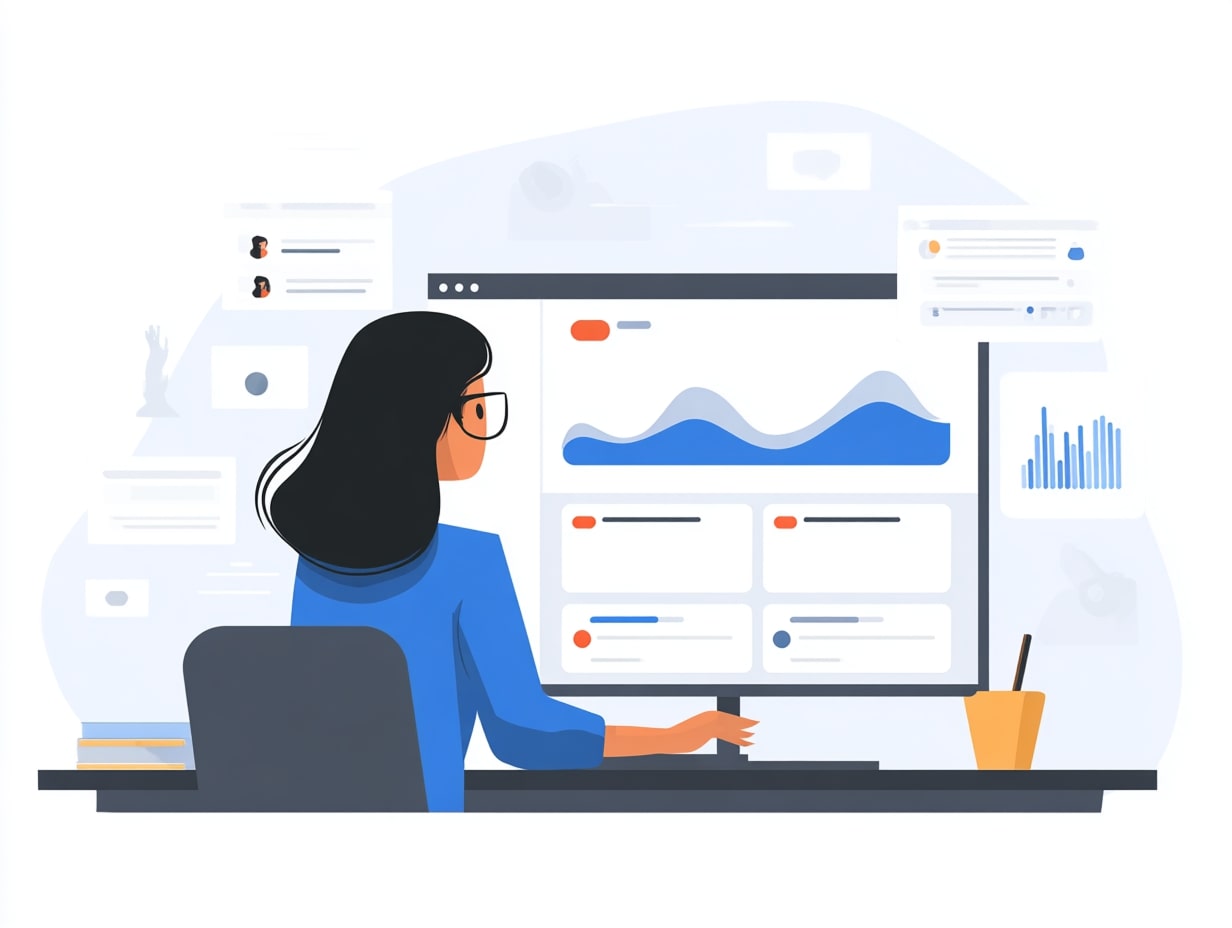
In addition, a high level of link popularity accelerates the indexing of new pages and increases content reach. Search engines visit websites with extensive and high-quality link profiles more frequently, which contributes to the faster appearance of new materials in search results.
The right combination of the quantity and quality of external links is the foundation for improving the link profile and an effective link popularity campaign. Utilizing strategies for building link popularity not only helps to boost a site’s rankings but also strengthens its trustworthiness with search engines.
How to Analyze Link Popularity?
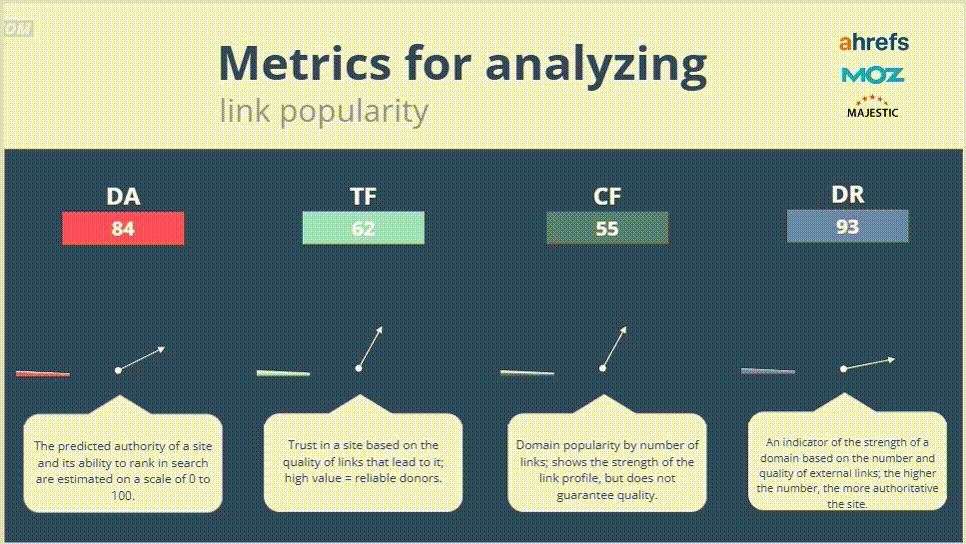
Effective website promotion is impossible without regular analysis of a website’s link popularity. It allows you to understand which external links truly enhance the resource’s authority and which may be of little benefit or even harmful.
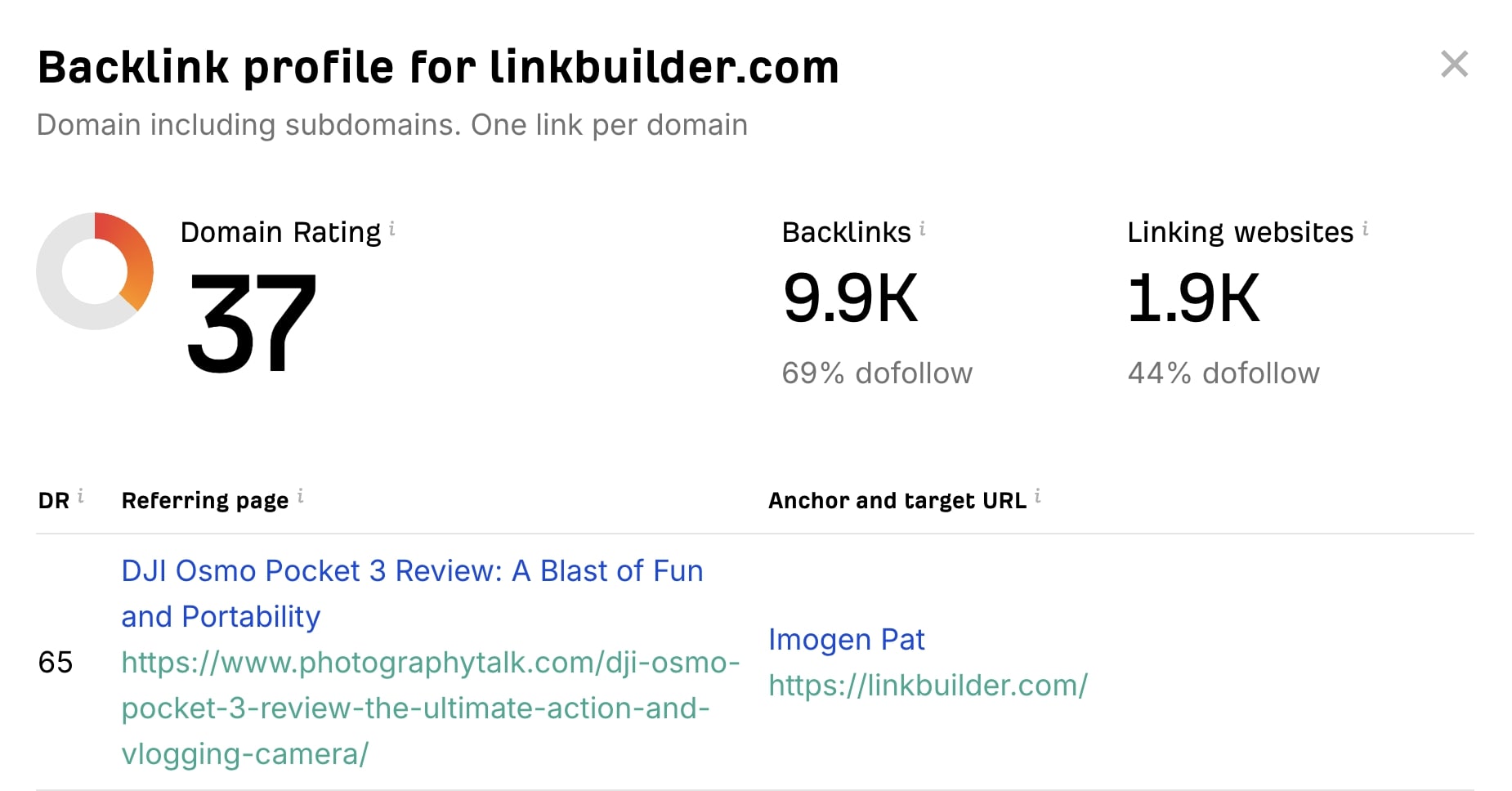
The main metrics for evaluating link popularity include:
- Domain Rating (DR) from Ahrefs and Domain Authority (DA) from Moz – these are domain authority metrics that reflect its strength in the eyes of search engines. The higher these values are for donors, the more valuable the link they pass to your site.

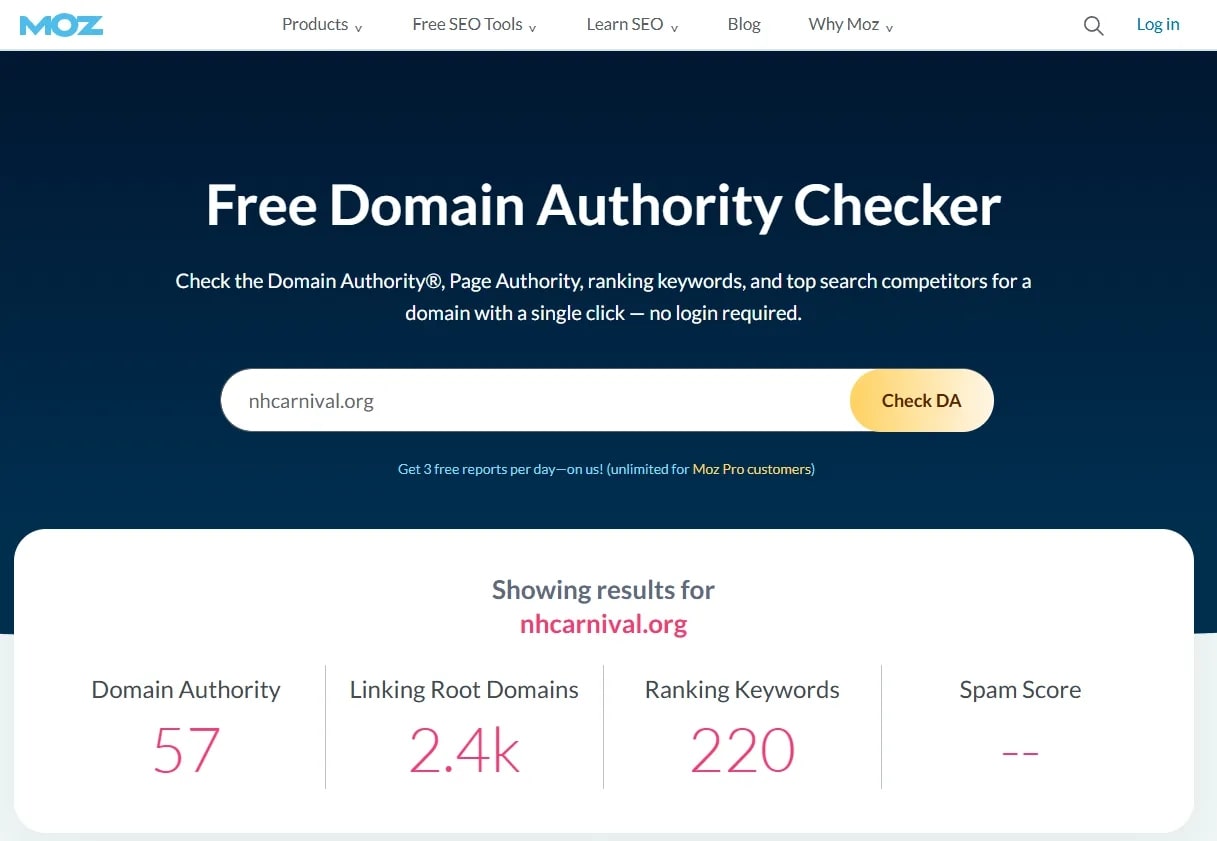
- Trust Flow / Citation Flow – metrics from Majestic that help assess the quality and trustworthiness of links. Trust Flow indicates how reliable the donors are, while Citation Flow shows the overall link potential of the site.

- The number of referring domains and their quality – a parameter considered in most SEO tools (Ahrefs, Majestic, Semrush, etc.). It is important not only the number of links but also the diversity and authority of the sources. Links from thematically relevant and trustworthy sites significantly enhance the effectiveness of link-building for site promotion.

By using professional tools for link popularity analysis, you can track the dynamics of your link profile, identify weaknesses, and adjust your link popularity building strategies. Regular analysis helps build a quality link profile, minimize the risk of penalties, and improve the site’s ranking in search results.
Tools for Link Popularity Analysis
To effectively conduct link popularity analysis and track the dynamics of improving a website’s link profile, specialized tools and services are used. They allow you to assess both the quantity and quality of external links, identify strong and weak donor sites, and build strategies for link popularity building.
The most popular tools for link popularity analysis include:
- Ahrefs – a powerful service for assessing external links, analyzing anchor lists, and monitoring the link profile.
- Majestic – helps measure Trust Flow and Citation Flow, identify trusted donors, and evaluate link quality.
- Semrush – a comprehensive platform for competitor analysis, link profile assessment, and SEO metrics.
- Serpstat – a tool for monitoring links, analyzing link mass, and finding new donors.
- Google Search Console – a free service from Google that allows you to track the quantity and quality of external links indexed by search engines.
The use of these services is crucial for planning link popularity campaigns and allows for building a high-quality link profile that genuinely impacts a website’s search engine rankings and its trustworthiness in the eyes of search engines.
Data Interpretation and Monitoring of Link Popularity
Once the link popularity analysis of a website is conducted using tools like Ahrefs, Majestic, or Semrush, it is important to correctly interpret the reports.
- How to determine if the profile is high-quality: Pay attention to the number and diversity of referring domains, the dofollow/nofollow ratio, thematic relevance of the sources, and Trust Flow/Domain Rating metrics. A good link profile is characterized by a steady growth of links from authoritative and relevant websites without sudden spikes, indicating a natural link popularity.
- Tracking dynamics and lost links: Regular monitoring allows you to promptly notice the loss of valuable links and adjust your strategy. Losing links from trusted domains can affect the link equity of the site, so it is important to maintain systematic oversight to ensure that the improvement of the link profile is continuous and deliberate.
A systematic approach to data interpretation and trend tracking is the key to an effective link popularity campaign and building a quality link profile.
Methods for Increasing Link Popularity
There are various approaches to building a website’s link popularity, which can be roughly divided into several categories. Natural methods include creating quality content, guest posts, and collaborations with experts that attract links organically. Paid methods involve purchasing or renting links through specialized link popularity services. Free methods include viral content, participating in affiliate programs, and crowd marketing. Additionally, a modern trend is Digital PR – a comprehensive set of activities for brand promotion and creating media and social media mentions, which contributes to forming a strong and diverse link profile.
Natural Methods
Effective website promotion requires a comprehensive approach to building link popularity. One of the main directions is the natural methods of acquiring external links, which are not only safe for SEO but also contribute to the formation of a sustainable and high-quality link profile.
- Link baiting – the creation of viral content, research, infographics, or unique materials that naturally attract links from other resources. This allows for an organic increase in a website’s link popularity without direct intervention in the link placement process.
- Guest posts – publications on niche blogs and portals that mention your resource. This approach helps build a quality link profile, increasing visibility and trust from search engines.
- Interviews and collaborations with experts – joint materials, quotes, and mentions in articles by authoritative specialists create natural links and strengthen the website’s link authority.
- Press releases and media mentions – publications on news portals and industry resources boost brand recognition and contribute to the organic growth of link popularity.
- Crowd marketing – placing links on forums, directories, and social networks. When implemented correctly, this helps expand reach and maintain the natural growth of the link profile without the risk of penalties for spam.
Using these natural methods to increase link popularity allows you to safely strengthen your website’s position, enhance search engine trust, and create a foundation for further link popularity building strategies.
Paid Methods
For comprehensive website promotion, it is important to combine natural, paid, and free methods to increase link popularity, in order to create a safe and effective link profile.
- Buying Links – placing links through exchanges or directly on trusted resources. This approach allows for a quick increase in a website’s link popularity, but requires caution to avoid violating search engine guidelines.
- Renting Links from Trusted Websites – temporary placement of links on authoritative platforms. This helps boost the website’s link weight and strengthen its position in search results, especially when time for promotion is limited.
Free Methods
- Participation in affiliate programs – exchanging links with thematic resources and joint campaigns allows you to obtain quality mentions without direct costs.
- Organizing events and webinars – drawing attention from the audience and industry specialists creates natural links that enhance a website’s link popularity.
- Engaging with communities and blogs – active participation in professional forums, blogs, and social networks contributes to the growth of the link profile and strengthens search engine trust.
Using these paid and free methods in combination with natural approaches allows for the building of a systematic strategy and answers the question of how to build link popularity, forming a quality link profile and ensuring consistent growth of the website’s visibility in search.
Digital PR as a method to increase link popularity
Modern link promotion actively utilizes Digital PR – a set of activities aimed at creating brand mentions and content in media and social networks. This approach allows for the formation of natural and high-quality external links, which strengthen the link profile and increase search engine trust.
- Collaboration with bloggers and journalists – publications and reviews on authoritative platforms attract links from relevant resources, expanding the audience.
- Creating newsworthy events – organizing events, studies, press releases, or viral campaigns generates newsworthy content that leads to mentions and links from media, forums, and social networks.
Using Digital PR in combination with natural, paid, and free methods allows you to build a systematic strategy, forming a high-quality link profile and ensuring the long-term impact of links on site ranking.
LinkBuilder.com turns Digital PR into a tool that works for your reputation, traffic, and SEO impact. We offer:
- Development of a personalized strategy based on in-depth research of the business, niche, and target audience.
- Creation and packaging of news hooks that are genuinely interesting to journalists and media outlets.
- Personalized work with editors and journalists: no automated mailings, only manual outreach tailored to specific media positions.
- Quality control at every stage: from stylistics and factual accuracy to compliance with the platform’s format.
- Transparent reporting: you can see how Digital PR impacts brand awareness, traffic, and trust.
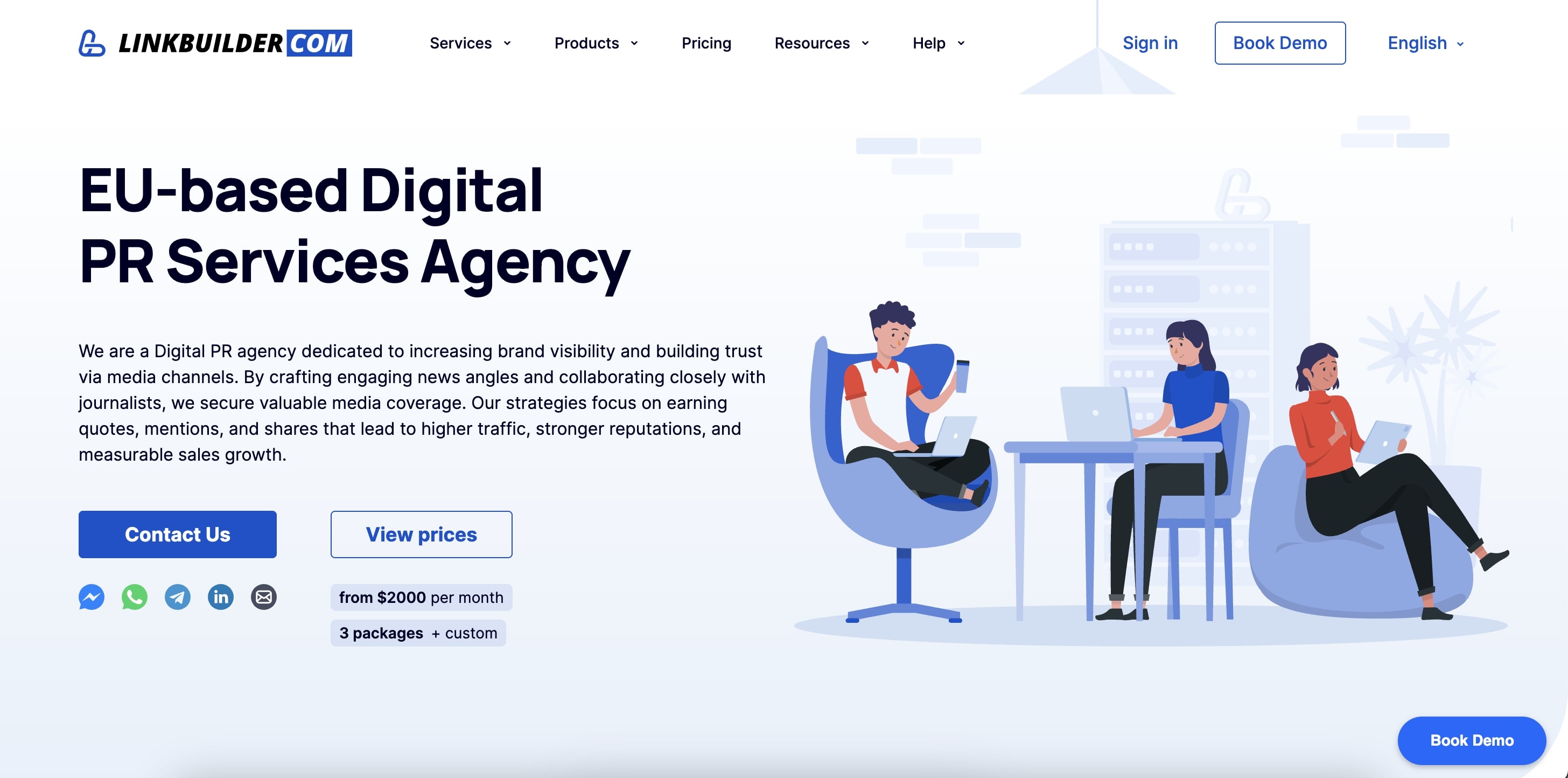
If you want to not just build links but create a lasting media presence for your brand, order Digital PR at LinkBuilder.com. We will handle the entire cycle: from analysis and development of news hooks to media negotiations, placement, and reporting.
Strategies for Effective Link Popularity Building
An effective link popularity campaign requires a well-thought-out approach. Incorrect or rapid link building can lead to penalties from search engines, so it’s important to follow strategies that ensure sustainable growth and maintain the website’s authority. Key methods for building a quality link profile include gradualness, relevance, and consideration of link geography.
- Gradual increase to avoid filters.
A sudden increase in the number of external links can raise suspicions with search engines. Therefore, it is important to gradually build link popularity by implementing links for website promotion in stages. This approach allows a site to safely increase link weight while simultaneously improving the understanding of how external links work for SEO.
- Relevance and authority of donors.
The quality of links is more important than their quantity. Links from authoritative and thematically relevant resources significantly enhance a website’s popularity in search. When building link popularity, you should choose sources that align with your website’s theme so that each donor strengthens the search engines’ trust in your project.
- Geographic targeting of links.
If your site is targeted at a specific region, consider the geography of the donors. Links from resources that are popular in your target country or city help search engines more accurately determine the website’s relevance to the audience and improve local search rankings. This approach is particularly effective when building a quality link profile for regional projects.
- Diversity of anchors.
Anchor text plays a key role in distributing link weight. Using uniform anchors can raise suspicions with search engines and reduce the effectiveness of a link popularity campaign. A variety of anchors – from exact match keywords to branding and natural phrases – helps build an organic link profile and increases the likelihood that search engines correctly assess what determines a website’s popularity in search.
- Mixed profile (dofollow/nofollow/sponsored/UGC).
To safely build link popularity, it is important to use different types of links. Dofollow links pass link weight, but relying solely on them is risky. Including nofollow, sponsored, and UGC links makes the profile more natural and reduces the likelihood of filters from search engines. This approach helps manage how to increase a website’s link weight without violating SEO rules.
- Use of microdata.
Microdata structures information on the site and allows search engines to better interpret links. It can specify link types, ratings, authorship, and other parameters, enhancing the effect of external links for SEO. When building a quality link profile, implementing microdata increases the transparency of links for search engines and makes the link popularity campaign more effective.
Link Popularity in the Zero-Click Era: Strategies for Attracting Traffic Without Direct Clicks
Modern search engines increasingly display results where users receive answers without visiting a website, known as Zero-Click. This can include knowledge carousels, snippets, quick answer boxes, maps, article quotes, and content widgets. In such conditions, the number of direct clicks from search results may decrease; however, link popularity remains a key factor for ranking and gaining trust in a website. Here’s why links are important in the Zero-Click era:
- Authority Signal: Even if a user doesn’t click, search engines consider external links as an indicator of the content’s value and relevance.
- Enhancing SERP Visibility: Quality links increase the chances of appearing in featured snippets, carousels, and knowledge panels, where clicks are not necessary to assess quality.
- Extending Reach Through Mentions: Links in articles, press releases, and blogs build brand context that users see in previews and result cards.
Building link popularity is crucial for maintaining a website’s presence and authority in the digital landscape.
Even when direct traffic from search decreases, links remain a key tool for strengthening a website’s authority and visibility in search results. An effective promotion strategy in the Zero-Click era is built on a combination of diverse links, media mentions, and content that attracts citations.
- Digital PR and media mentions – Publications in media outlets and blogs create natural links, increase search engine trust, and enhance the chances of appearing in snippets.
- Content with citation value – Analytical reviews, infographics, unique studies. These materials are often mentioned by other sites, creating indirect links even if users do not click directly.
- Crowd marketing and niche forums – Brand and product mentions in discussions enhance trust in the site and create a natural link profile.
- Social media and aggregators – Links from social media may not always provide direct SEO value, but they help search engines track content popularity, indirectly influencing ranking.
Thus, a successful link popularity strategy in the Zero-Click era combines quality and diversity of links, relevant content, and media mentions. Even if users do not click directly to the site, a well-structured link profile creates a long-term effect: it strengthens search rankings, increases brand recognition, and builds sustainable trust with both algorithms and the audience.
Decentralized Link Building: Blockchain Solutions for Transparency and Trust in Link Profiles
As SEO evolves and search engines focus more on link quality, there is growing interest in new technologies that provide transparency and security in link building. One promising direction is decentralized link building using blockchain technology.
Why It Matters
Traditional link building methods often face challenges:
- Unreliable donors. Sometimes links are placed on sites with questionable reputations.
- Lack of transparency. Clients cannot always verify the actual placement or change the publication terms.
- Risk of penalties. Hidden schemes, PBNs, and low-quality platforms can lead to ranking drops.
Incorporating link popularity analysis and link popularity tools can help ensure that a website’s popularity is determined by genuine and trustworthy sources.
Blockchain addresses these challenges through a decentralized, immutable record of all transactions. Each link placement is recorded on the network, making the link history transparent and verifiable.
Advantages of Decentralized Link Building
- Transparency and Trust – every network participant can verify the authenticity of a link, its source, and the date of placement.
- Security and Resistance to Manipulation – the inability to forge a link record reduces the risk of manipulation and penalties.
- Automation and Cost Accounting – smart contracts allow for automatic recording of payment for placements and compliance with terms, minimizing disputes between parties.
- Reputational Rating of Platforms – blockchain enables the creation of open donor ratings based on real link data, simplifying the selection of quality resources.
How This Changes the Approach to Link Popularity
Decentralized link building allows for the creation of a natural and verifiable link profile that simultaneously satisfies search engine algorithms and builds trust with users and partners. In such conditions, promotion ceases to be a “black box,” and every participant in the chain, from the content creator to the client, sees real metrics and results.
With the implementation of blockchain solutions, link building is gradually transforming into a system with open reporting, where the risk of sanctions is minimized, and the cost and effectiveness of placements become predictable. In the long run, this creates a more honest and competitive link market where a website’s popularity is determined not by manipulation schemes but by the quality and transparency of its link history.
How to Run a Link Popularity Campaign?
Running a link popularity campaign is a systematic effort aimed at strengthening a site’s authority and increasing its visibility in search engines. The right strategy not only involves building links but also creating a high-quality link profile that is resilient to algorithm changes and effectively conveys the site’s link equity.
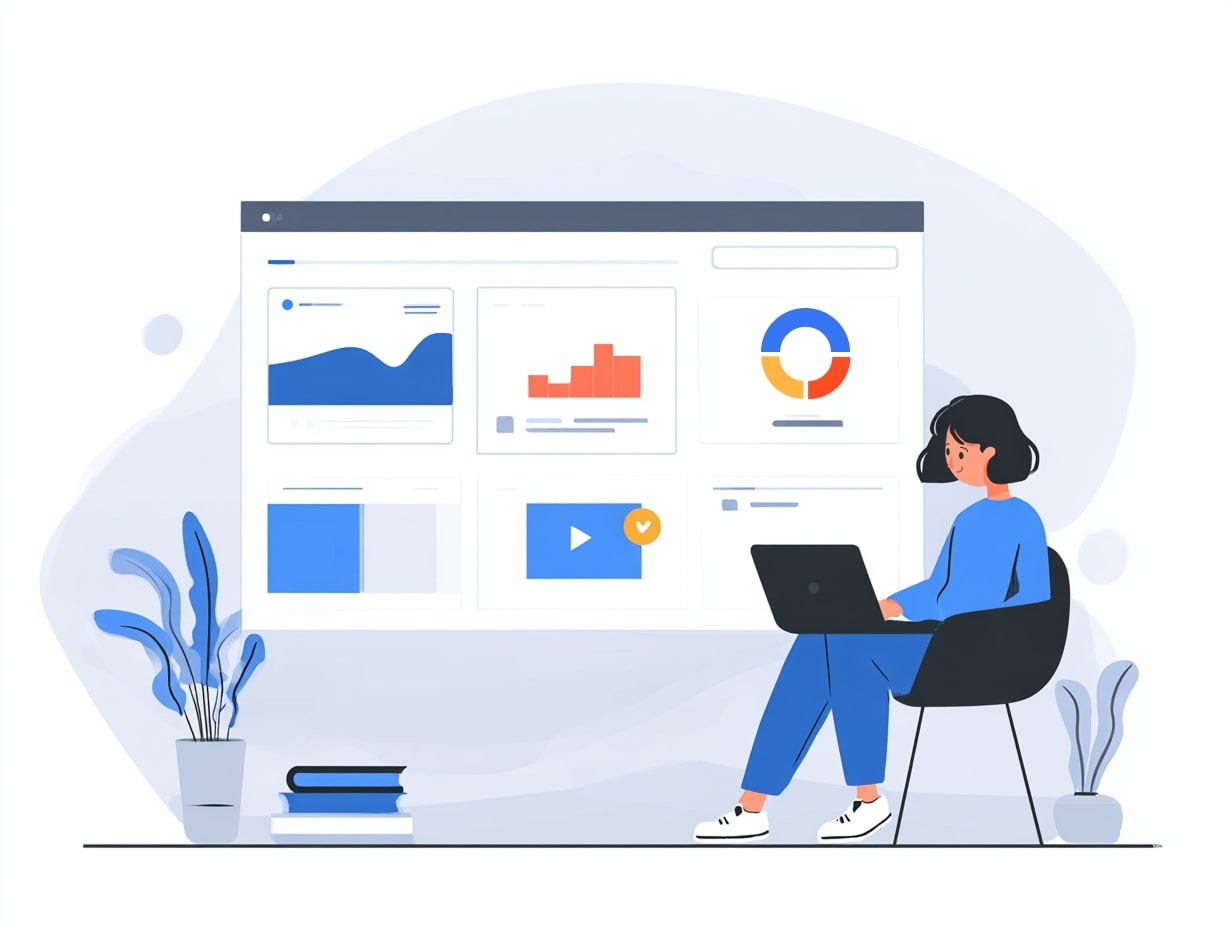
Campaign Stages
- Audit of the current link profile.
Before building new links, it is essential to understand what external links already exist, their weight, and quality. An audit helps identify strengths and weaknesses, determine how external links work for SEO on your site, and create a plan to improve link popularity.
- Finding donors (thematic, trusted).
Choosing the right donors is key to a successful campaign. Links from authoritative and thematically related resources significantly boost search rankings and strengthen trust in the site. It is important to consider that a website’s popularity is determined not only by the number of links but also by their quality and relevance.
- Link placement (gradually, without spam).
Building link popularity should be gradual to avoid search engine filters. It is optimal to combine different types of links, ensure the naturalness of anchors, and consider content relevance. This directly affects how to safely increase the site’s link weight.
- Monitoring indexing and dynamics.
After placing links, it is important to track how search engines index new donors and observe position dynamics. Such control allows for timely strategy adjustments and maintaining a stable increase in link popularity.
- Recovery of lost links.
Links can disappear for various reasons: site closures, page structure changes, or content removal. Regular monitoring and recovery of lost links help preserve accumulated link weight and continue building a quality link profile.
- Disavow harmful links (Disavow Tool).
Links from low-quality or dubious sites can negatively impact search rankings. Using tools to disavow such donors helps minimize risks and improve the effectiveness of the link popularity campaign.
Mistakes in Building Link Popularity
Even a well-executed link popularity campaign can backfire if risks are not taken into account. Many website owners make common mistakes that reduce the effectiveness of external links for SEO and can impact the site’s search rankings.
- Sharp increase in link volume.
A disproportionate increase in the number of links over a short period raises suspicion from search engines and can lead to filters or penalties. Gradual link building for website promotion ensures a stable increase in link weight and allows for safely building a quality link profile.
- Toxic donors (satellite sites, link farms).
Links from low-quality or dubious resources can harm the website’s reputation. Such donors not only fail to improve the site’s popularity in search but can also lead to penalties. When building link popularity, it is important to choose trustworthy, thematically relevant sources.
- Anchor text over-optimization.
Using the same keywords in anchor texts for all links appears unnatural. This reduces the effectiveness of a link popularity campaign and can trigger penalties. Diversifying anchor texts and naturally integrating links help safely increase a website’s link weight.
| Error | Consequences | How to Avoid |
|---|---|---|
| Sudden increase in link mass | Search engines’ suspicion, filters, ranking drop | Gradual link building, safe time distribution |
| Toxic donors (satellite sites, link farms) | Loss of trust from search engines, potential penalties | Use only trustworthy and thematically relevant resources |
| Anchor text over-optimization | Unnatural profile, decreased link effectiveness | Anchor diversity: exact keywords, branding, natural phrases |
How Popular Links Affect Ranking
Links remain one of the key ranking factors, but search engine algorithms are constantly becoming more sophisticated to prevent manipulation. In 2025, Google actively uses AI algorithms like SpamBrain to detect attempts at artificial link mass building. Understanding how to build link popularity safely and effectively is critically important: only organic link growth allows for building a quality link profile and strengthening a website’s authority in the eyes of search engines.
How Google Fights Manipulations (AI Algorithms, SpamBrain)
Modern Google algorithms, including the AI system SpamBrain, comprehensively analyze websites and can detect attempts at artificially building link popularity. The system evaluates the quality of donors, content relevance, anchor distribution, and the naturalness of the link profile. Any abrupt spikes in the number of links, links from toxic sites, or uniform anchors may be classified as manipulations.
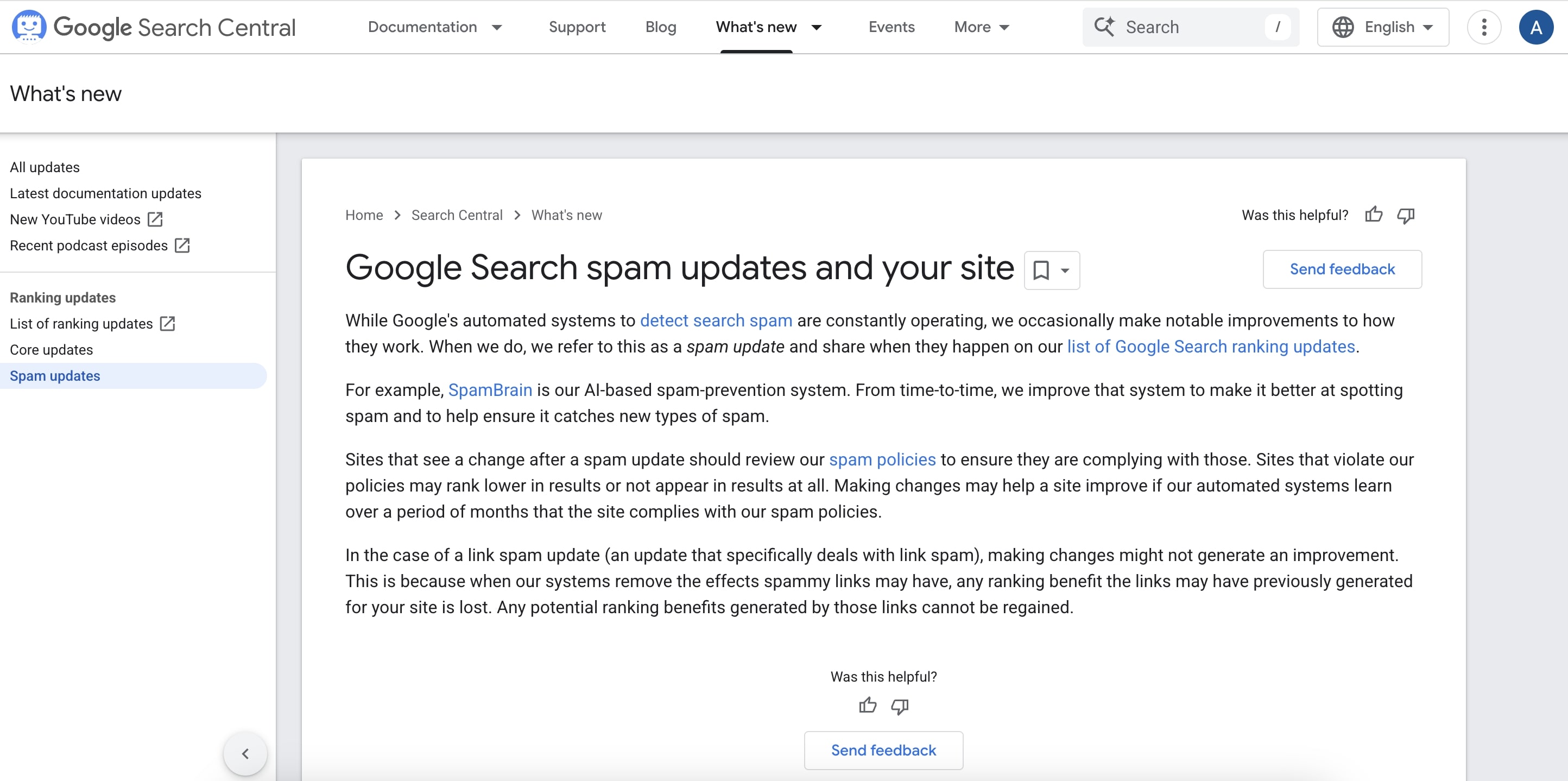
SpamBrain not only filters low-quality links but also considers the site’s context and user behavior signals to determine which resources genuinely value the content and which create an artificial effect of popularity. Therefore, building a quality link profile becomes critically important: it helps safely strengthen the website’s authority and enhance link popularity without the risk of penalties.
The success of promotion depends not on the quantity of links but on their naturalness, the authority of donors, and integration into an organic promotion strategy, which makes careful work with external links the foundation of any campaign to improve a website’s visibility.
The Importance of Quality Over Quantity
In 2025, the number of links ceased to be the main indicator of a website’s popularity. Search engines began to focus on the quality of external links and their impact on the site’s trustworthiness. Flooding a site with dozens or hundreds of links from low-profile or irrelevant resources no longer works. On the contrary, such actions can decrease a site’s authority and worsen its rankings.
Think of links as reputation: it’s better to receive a few recommendations from respected experts than hundreds from unfamiliar individuals. Building a quality link profile means that each link should be relevant to the site’s topic, placed on a trustworthy resource, and have an organic anchor. This approach ensures a natural increase in link popularity and allows for the safe enhancement of a website’s link weight.
For example, one link from an authoritative industry portal can have an effect dozens of times stronger than dozens of links from low-traffic sites. Therefore, when planning a promotion campaign, it’s important to focus on the quality of donors and the relevance of links, rather than their quantity. This is the key to sustainable growth in search engine visibility.
The Role of EEAT and Semantic Analysis
Search engines continue to refine their ranking algorithms, and the impact of link popularity on a website’s positions is closely tied to the concept of E-E-A-T – Experience, Expertise, Authoritativeness, Trustworthiness. Google and other major search engines no longer evaluate websites solely based on the number of links.
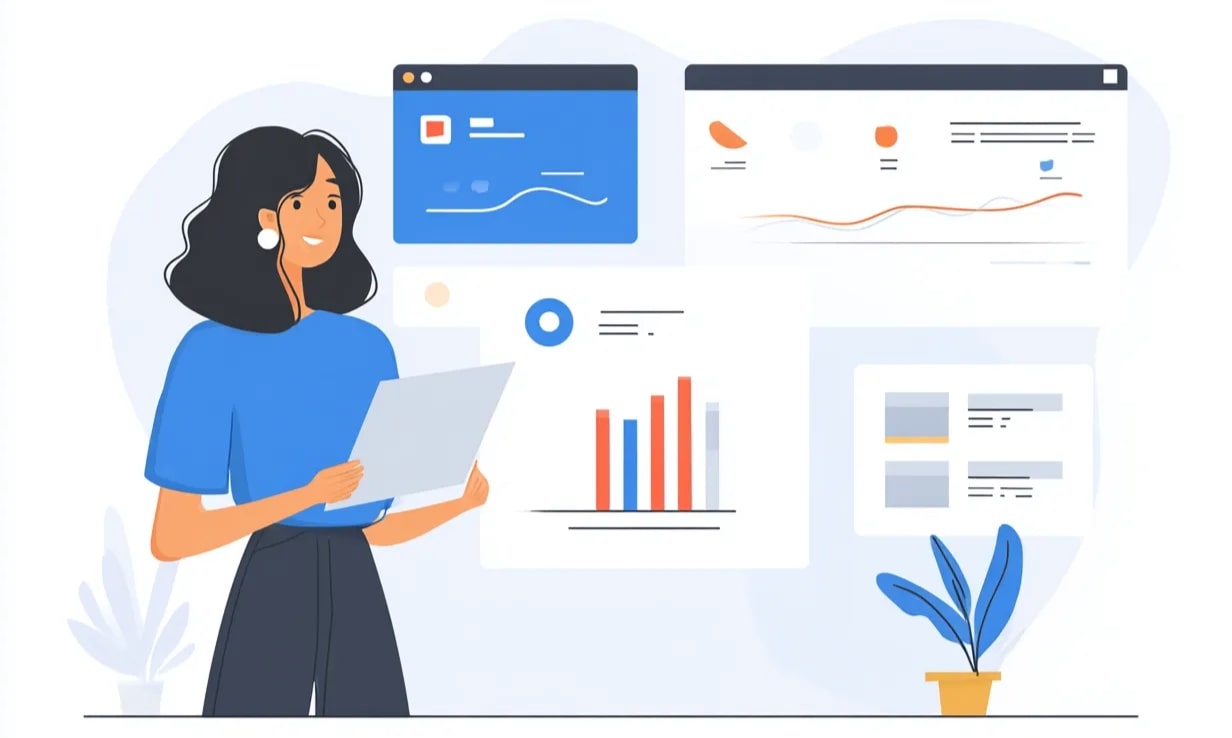
- Experience and Expertise
Search engines pay attention to who is behind the content and links. Links from resources where authors have verified experience and expertise in a specific niche significantly enhance a website’s value in the eyes of algorithms. Even if an external link comes from a low-traffic resource, if the author’s authority is high, such a signal is considered much stronger than “mass” links from low-quality platforms.
- Authoritativeness and Trustworthiness
Algorithms analyze how well a link confirms the authority and trust of the content. Links from sites that the search engine trusts, with thematically related publications, strengthen the E-E-A-T signal. It is important to consider not only the number of links but also their context: where and how the brand, product, or expert is mentioned.
- Semantic Link Analysis
Modern algorithms increasingly rely on semantic analysis of the content surrounding links. This means that not just the link text (anchor) is important, but also the context in which it is placed: the proximity of key thematic words, semantic connections between pages, and the degree of topic relevance. Links to pages with high thematic proximity to your content exert a stronger influence on ranking than irrelevant or random mentions. Building link popularity in SEO involves focusing on these aspects to improve a website’s authority and trustworthiness.
It is essential to strategically choose sources with high expertise, authority, and trustworthiness, as well as consider the semantic context in which links are placed. This approach ensures a natural growth of link popularity, enhances the site’s E-E-A-T, and directly impacts search engine rankings.
Alternatives to Links: Brand Mentions, Behavioral Signals
Search engines actively consider indirect signals that also reflect a website’s popularity and trust. Among these, brand mentions and user behavioral factors play a key role.
- Brand Mentions
Even if your brand mention isn’t accompanied by a link, search engine algorithms may consider it as an indicator of authority. Contextual mentions on relevant resources demonstrate that a site or brand is trustworthy and of interest to the audience.
- Context Over Quantity: Search engines analyze where and how a brand is mentioned, and how well it aligns with the theme of your niche.
- Connection to E-E-A-T: Natural mentions on authoritative resources enhance the expertise and trust in your site, especially when it comes to specialized topics.
- User Signals
User interaction with a site has become one of the key ranking factors. Even with a limited number of external links, search engines may consider behavioral metrics as quality indicators:
- CTR in Search Results: A high click-through rate of the snippet indicates the relevance of your content.
- Time on Site and Depth of Visit: If users spend more time and view multiple pages, algorithms interpret this as a signal of content value.
- Returns and Repeat Visits: Regular user returns increase trust in the resource, which indirectly strengthens link popularity through brand authority.
Modern SEO requires a comprehensive approach. In addition to traditional link building, it is important to:
- Encourage natural brand mentions in relevant publications, forums, and social media;
- Enhance user experience on the website so that behavioral signals reflect high-quality content;
- Analyze the context of mentions and audience reactions to optimize promotional strategies.
Even without actively building link popularity, a website’s positions in search can be strengthened by using alternative signals of trust and popularity.
Revolution in Link Popularity: How AI is Changing the Game
Artificial Intelligence (AI) is radically transforming SEO and link building, changing the approaches to evaluating, creating, and managing links. Today, AI is used not only for data analysis but also for developing promotional strategies, selecting donors, and optimizing the link profile.
AI in Link Profile Analysis
Modern algorithms allow for automatic:
- Evaluate the quality of donors and link relevance based on hundreds of factors: topic, domain authority, link history, user behavioral signals.
- Identify toxic links and potential risks – AI quickly detects suspicious sites, PBN networks, or low-trust platforms, reducing the risk of penalties.
- Model competitors’ link profiles – AI can predict which links influence ranking growth and adapt your own strategy.
AI in Link Content Creation
Artificial intelligence not only eases the work of SEO specialists but also opens new opportunities for quality and strategic link popularity building through content.
- Generation of Unique Content for Donors
AI enables the creation of articles, press releases, infographics, analytical reviews, and other materials that consider the theme, style, and interests of the target audience. For example:
- Articles and Reviews: AI analyzes popular queries, industry trends, and competitors’ content to offer relevant and useful texts that will organically attract links.
- Press Releases: AI helps structure news materials so that they appear natural to media outlets and increase the likelihood of publication with a link.
- Infographics and Visual Materials: AI can generate infographic concepts and visual elements that are easily spread across blogs and social networks, creating natural mentions and citations.
- Automatic Optimization of Anchor Lists and Internal Links
AI assists in forming a natural and diverse anchor profile that aligns with search engine algorithmic signals:
- Analyzes existing links and competitors’ anchor texts.
- Selects relevant keywords considering frequency and natural usage.
- Recommends the distribution of anchor text across pages to avoid over-optimization and unnatural profiles.
- Optimizes internal links on the website for more even weight distribution among pages, enhancing their importance in the eyes of search engines.
- Personalization and Segmentation of Content
AI allows for the adaptation of content to specific audiences and market segments, increasing the effectiveness of links and conversions:
- Audience Segmentation: AI analyzes user interests, demographics, and behavior to create materials that are most appealing to a specific group of donors.
- Personalized Recommendations: Unique formats and content themes are selected for each segment to maximally stimulate link publication.
- Testing and Optimization: AI automatically evaluates which materials attract more links and mentions and suggests adjustments to increase effectiveness.
Using AI for link popularity building can significantly enhance your link popularity in SEO efforts. By generating unique content and optimizing links, a website’s popularity is determined by its ability to attract and maintain organic connections.
AI, Performance Forecasting, and Combating Manipulation
Modern artificial intelligence opens up new opportunities for forecasting and controlling the link profile. With its help, specialists can assess the impact of each link on site rankings and traffic flow by using large datasets and complex analysis algorithms. AI takes into account not only historical indicators and competitor dynamics but also current industry trends, seasonality, user behavioral signals, and even the quality of content on donor sites. This enables marketers to build accurate, predictable, and cost-effective promotion strategies, minimizing the risks of investing in ineffective links.
Alongside forecasting, AI plays a key role in combating manipulation and low-quality promotion schemes. Search engines are increasingly using machine learning algorithms to detect inflated link networks, PBNs, and other dishonest practices. In response, SEO specialists use AI to create a natural, safe, and diverse link profile, effectively enhancing link popularity in SEO.
- Donors with a verified reputation and relevant topics are automatically selected.
- Anchor lists and link distribution are formed to appear natural in the eyes of algorithms.
- Content is optimized so that links are seamlessly integrated into the texts, enhancing value and trust from search engines.
As a result, using AI allows for simultaneously increasing the effectiveness of link promotion and reducing the risk of penalties, creating a strategy that works in the long term and adapts to changes in search engine algorithms.
How AI is Changing the Strategic Approach to Link Popularity
With the application of AI, link building becomes a manageable process rather than an intuitive or manual task. Specialists can now:
- Build a predictable growth in the link profile
- Adapt the strategy in real time
- Combine digital PR, crowd marketing, and other promotion methods with high precision
- Minimize the risks of penalties and ineffective investments
A website’s popularity is determined by how well these strategies are implemented, making AI an essential tool in the link popularity campaign.
Ultimately, AI heralds a new era in link popularity, where quality, transparency, and predictability take center stage, while manual and intuitive approaches gradually give way to analytics and automation.
Who can assist in building link popularity?
Today, the market offers dozens of tools and approaches for building link popularity – from crowd marketing to comprehensive Digital PR campaigns. However, for these methods to truly work, expertise, a systematic approach, and access to verified link sources are essential.
At LinkBuilder.com we consolidate all the key services for enhancing link popularity in one place – from finding relevant donors to implementing large-scale strategies. Our experience (10+ years in link building) and proprietary technology allow us to create link profiles that meet search engine algorithm requirements and deliver predictable results.
What we offer:
- The largest database of platforms for guest posts and placements – hundreds of thousands of websites worldwide with filters by DR/DA, traffic, niche, language, region, and other SEO metrics.
- Free link building tools – crowd links, submissions, contextual links, and more, which help build a natural link profile background.
- Turnkey services – guest posting, Digital PR, HARO, AI SEO, indexing acceleration, copywriting, and comprehensive strategies.
- Personal account and subscription – manage all projects from a single panel, transparent statistics, placement history, and priority support.
- Regular database updates – thousands of new platforms added monthly so you always have access to fresh and high-quality donors.
By using these tools and services, you can effectively build link popularity and boost a website’s visibility in search engines.
Our goal is not just to place links, but to help you build a sustainable link ecosystem that will work towards improving rankings, traffic, and brand recognition in the long term.
If you want your website’s link profile to align with key search engine algorithm signals and deliver tangible results, start working with LinkBuilder.com today.
Conclusion
Link popularity remains an important ranking factor. A website’s popularity is determined by complex signals: content quality, the authority and trust of linking sources (E-E-A-T), semantic relevance, brand mentions, and user behavioral metrics. An effective promotion strategy requires the synergy of all these elements, rather than blindly increasing the number of external links.
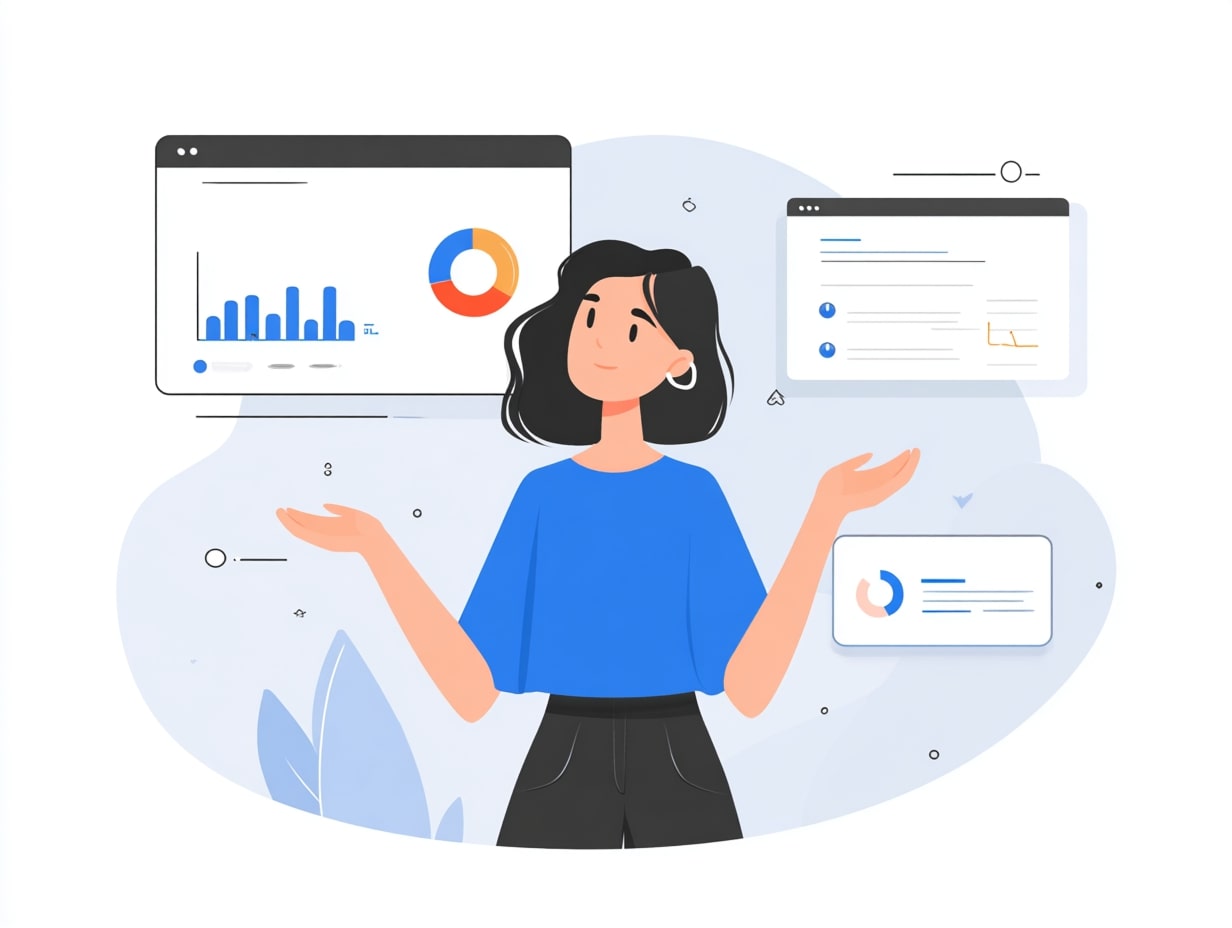
- Links remain critically important, but their value is determined by quality, context, and thematic relevance, not just quantity.
- Natural brand mentions and authoritative resources enhance trust and expertise, even if there are few direct links.
- User behavioral signals become an additional indicator of site quality and affect ranking.
- A comprehensive approach to promotion ensures stable growth in visibility and link popularity.
Checklist for Improving Link Popularity
- Content: Create expert, useful, and unique material that people want to quote and link to.
- Link Building: Build a network of external links on relevant and authoritative resources. Focus on the quality of links, not their quantity.
- UX (User Experience): Improve site usability, navigation, loading speed, and mobile responsiveness. Good UX increases user trust and reduces bounce rates.
- Behavioral Factors: Analyze how users interact with the site and optimize content to meet the real needs of the audience.
- Regularly check external links leading to your site to identify lost or broken links.
- Recover lost links through URL correction, redirects, or contacting resource owners.
- Natural links (natural brand mentions and organic citations) are the most valuable for E-E-A-T and search engine trust.
- Artificial growth (link exchanges, placements on third-party platforms) should be used moderately, strictly controlling the quality of sources to avoid algorithm penalties.
To enhance a website’s popularity, it’s essential to focus on quality link building. Utilizing link popularity tools can greatly aid in this process.
Comprehensive Promotion Recommendations
For sustainable growth in link popularity and improved search engine rankings, it is important to take a comprehensive approach to promotion by combining several directions:
- Content Strategy
- Create unique and expert content that addresses real audience queries.
- Integrate key themes and semantic clusters to enhance page relevance.
- Use multimedia (infographics, videos, interactive elements) to boost engagement and time on site.
- Targeted Link Building
- Develop a network of links from authoritative and thematically relevant resources.
- Aim for natural brand mentions and expert citations.
- Regularly analyze and update the link profile, restoring lost or poor-quality links.
- UX and Behavioral Factors Optimization
- Improve user experience: loading speed, responsiveness, navigation, and ease of interaction.
- Analyze behavioral signals: CTR, page depth, time on site, and user returns.
- Tailor content and interface to the real needs of the audience to increase engagement and trust.
- Integration of E-E-A-T and Semantic Analysis
- Ensure your content and links demonstrate expertise, authority, and trustworthiness.
- Use semantic analysis for topic selection, link context, and relevant keywords.
- Continuous Monitoring and Strategy Adjustment
- Regularly conduct SEO audits of the site and link profile.
- Evaluate the effectiveness of link, mention, and content campaigns.
- Make data-driven changes to keep the strategy flexible and up-to-date.
By following these strategies, you can effectively build link popularity and enhance your site’s overall SEO performance. Only an integrated approach that considers content, links, UX, behavioral signals, and expertise ensures sustainable link popularity growth and stable positions in search results.
